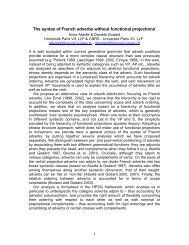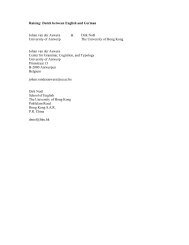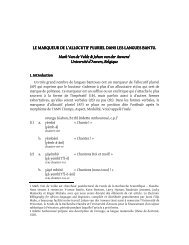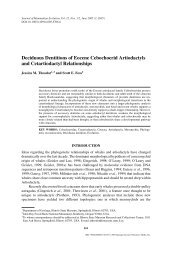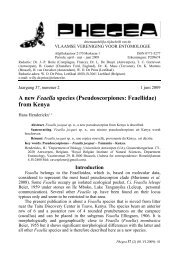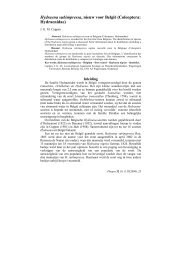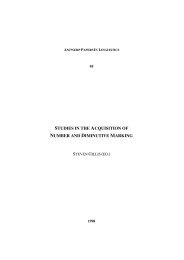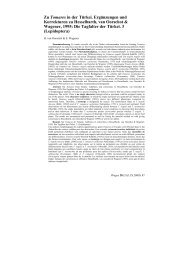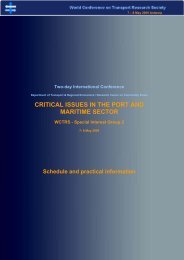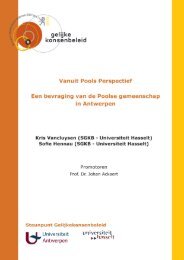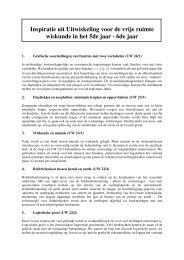Turtles as hopeful monsters
Turtles as hopeful monsters
Turtles as hopeful monsters
You also want an ePaper? Increase the reach of your titles
YUMPU automatically turns print PDFs into web optimized ePapers that Google loves.
What the papers say<br />
Figure 3. The relationship of the shoulder blade to the carapace in turtles (Graptemys geographica).<br />
later developmental stages. In the turtle carapace, therefore,<br />
the distinction of endoskeleton versus exoskeleton becomes<br />
problematic. It had been recognized earlier that the endoskeleton<br />
versus exoskeleton cannot be distinguished on the b<strong>as</strong>is<br />
of histogenesis, but must be defined with reference to a<br />
phylogenetic framework. (17,18) Exoskeletal elements are<br />
homologous to structures that in the ancestral condition<br />
combine bone, dentine and enamel, i.e., develop at the<br />
ectoderm±mesoderm interface. Thus, the bony scales of a<br />
trout, or the osteoderms of a crocodile, are exoskeletal,<br />
because these are structures that ultimately can be traced<br />
back (are homologous) to the heavy scales of early fishes that<br />
combine bone, dentine and enamel in a three-layered scale.<br />
By contr<strong>as</strong>t, endoskeletal elements are elements that in the<br />
ancestral condition are preformed in cartilage, while the<br />
cartilaginous stage may be deleted in the descendant<br />
(membrane bone). In the turtle carapace, the neural and<br />
costal plates ossify from, and in continuity with, the periost of<br />
their endoskeletal component. This pattern of ossification<br />
corresponds to the definition of Zuwachsknochen, (18) i.e.,<br />
bone that complements an endoskeletal element that is itself<br />
preformed in cartilage. As such, neural and costal plates are<br />
endoskeletal components of the turtle carapace, and cannot<br />
be derived from a hypothetical ancestral condition by fusion of<br />
exoskeletal osteoderms. All other parts of the turtle carapace<br />
are exoskeletal, however.<br />
The origin of a new body plan<br />
The turtle body plan is evidently highly derived, indeed unique<br />
among tetrapods. The problem for an evolutionary biologist is<br />
to explain these transformations in the context of a gradualistic<br />
process. Given the recently obtained developmental evidence,<br />
(1,11,13) the theory of ``correlated progression'' (10) presents<br />
an incomplete explanation of the turtle body plan:<br />
formation of the carapace is not simply the consequence of a<br />
fusion of osteoderms, and the location of the scapula inside the<br />
rib cage is not the result of a backward migration of the pectoral<br />
girdle.<br />
Early in the 19th century, EÂ tienne Geoffroy Saint-Hilaire<br />
raised the question of how the lung of a reptile could be<br />
transformed into the lung of a bird? He found it impossible to<br />
postulate that the lung of a reptile, specialized in its own way,<br />
could transform into an even more specialized lung of a bird.<br />
But he recognized that both reptiles and birds share similar<br />
early embryonic rudiments of the lung, and he hypothesized<br />
that these could develop along different trajectories in the<br />
two groups due to a minor change in early ontogenetic<br />
development: ``It only required an `accident' [a change] that<br />
990 BioEssays 23.11



